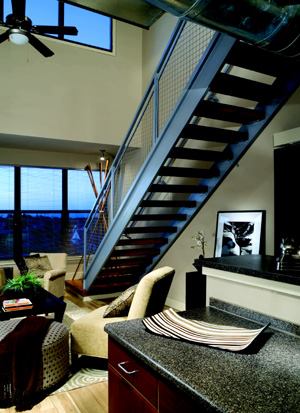Balconies or private gardens are key selling points for the studio units at Austin Ranch, a mixed-use, planned community in Plano, Texas. Developed by locally based Billingsley Development Co., Austin Ranch features 2,000 apartment units including 80 studios of roughly 500 square feet. “Because our residents have limited indoor space, we think it’s important to give them some sort of outdoor space,” explains Lucilo Pena, president of Billingsley.
Similarly, Market Street Village and Entrada feature balconies or decks. SRM Development also has added upscale finishes that are comparable to those found in condos. “Our tenants have demanded more quality finishes,” Rivard says. Market Street Village, for example, offers ceramic tile floors, stainless steel appliances, and maple cabinetry.
The Marquette in St. Louis also features a number of high-end elements including all wood cabinetry in the kitchen and bath, slate tiles, sconces, and oval mirrors. These little luxuries are encouraging The Lawrence Group to price the units at $1.25 per square foot, a rather pricey rental rate in a city renowned for its affordability, Leipziger points out.
The newest trend in defining space: half-walls, built-ins, and alcoves. “Using a screened half-wall to create a separate sleeping zone gives an element of privacy and also allows light to filter through the unit,” says Paul Campbell, principal of Kephart, a Denver-based design firm.
Campbell and his firm are currently working on plans for the renovation of a 340-unit apartment property in suburban Denver. The 1970s-era property has 220 poorly designed efficiency units with galley kitchens and no sleeping alcoves. The proposed design calls for a screened half-wall made of fabric or glass to separate the bedroom.
Alternatively, Lakeshore East’s studio units are designed in an “L” shape to create a sleeping alcove. “The alcove, which is about 8 feet by 9 feet, creates a sense of containment but still maintains the flow of the room,” Loewenberg says.
SRM Development is taking a new approach to the sleeping areas in the studio units in its newest apartment project in Bellevue, Wash. Set to break ground in the first quarter of 2007, the 262-unit property will have 50 “studio-lofts”—units that have raised platforms for the sleeping area, Rivard says. “We think the platforms are the next big thing in studio design,” he contends.
Half-walls created with built-in shelves, moveable islands, or bar-level islands create just the right amount of definition between the living room and kitchen. “You want to make sure that whatever you use still allows people to arrange their apartments to their taste rather than yours,” Harwick warns. Studio units in The Depot, an apartment project in down-town Fort Worth, have bar-level islands that create different “rooms” and also serve as eating areas, says Harwick, who designed the 210-unit property owned by Dallas-based Carleton Residential Properties.
